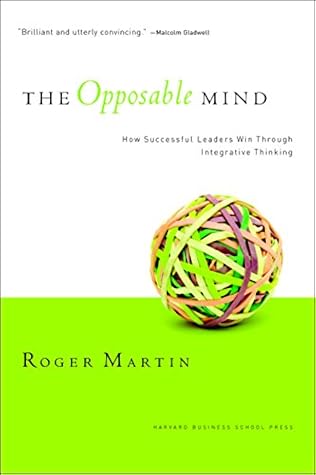More on this book
Kindle Notes & Highlights
Read between
August 13, 2018 - August 26, 2019
The test of a first-rate intelligence is the ability to hold two opposing ideas in mind at the same time and still retain the ability to function. One should, for example, be able to see that things are hopeless yet be determined to make them otherwise.1 —F. Scott Fitzgerald
The Chinese character for “crisis,” he pointed out to me, combines the characters for “danger” and “opportunity.”
in our daily lives, we often face problems that appear to admit of two equally unsatisfactory solutions. Using our opposable minds to move past unappetizing alternatives, we can find solutions that once appeared beyond the reach of our imaginations.
Integrative thinking is largely a tacit skill in the heads of people who have cultivated, knowingly or otherwise, their opposable minds. Many of those people don’t appear to know how they are thinking or that it is different from the common run of thought. They just do it. But an outsider can observe, describe, and analyze their thinking processes. And from this conscious, systematic study, a method of teaching that process is starting to emerge.
The first difference between integrative thinkers and conventional thinkers is that integrative thinkers take a broader view of what is salient.
More salient features make for a messier problem. But integrative thinkers don’t mind the mess. In fact, they welcome it, because the mess assures them that they haven’t edited out features necessary to the contemplation of the problem as a whole. They welcome complexity because they know the best answers arise from complexity. And they feel confident that they will not get lost along the way but emerge on the other side of the problem with a clear resolution.
Second, integrative thinkers don’t flinch from considering multidirectional and nonlinear causal relationships.
Fourth and finally, the integrative thinker will always search for creative resolution of tensions, rather than accept unpleasant tradeoffs.
When decisions go bad, sometimes it is because we got the causal links between salient features wrong.
Integrative thinkers are a varied lot, as we’ve seen. But their stances have in common six key features. Three concern the world around them; three concern their role in it. First, they believe that whatever models exist at the present moment do not represent reality; they are simply the best or only constructions yet made.
Second, they believe that conflicting models, styles, and approaches to problems are to be leveraged, not feared.
Fourth, they believe that not only does a better model exist, but that they are capable of bringing that better model from abstract hypothesis to concrete reality.
Fifth, they are comfortable wading into complexity to ferret out a new and better model, confident they will emerge on the other side with the resolution they seek.
And sixth, they give themselves the time to create a better model.


